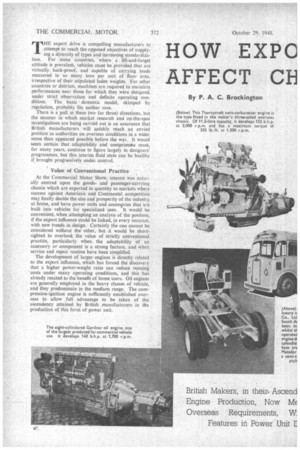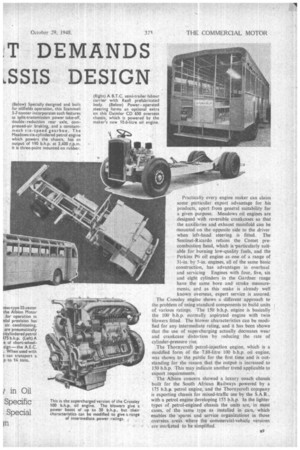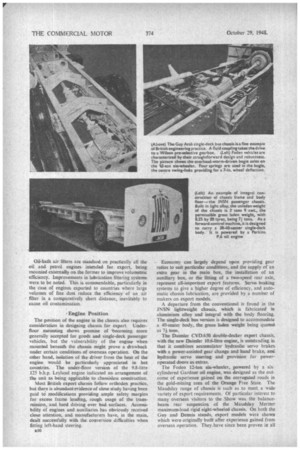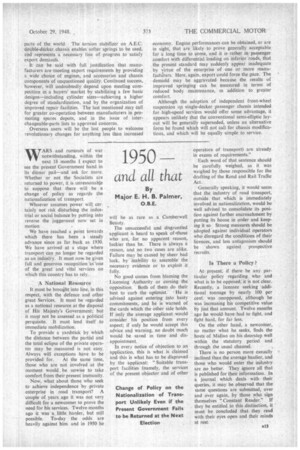HOW EXPO T DEMANDS AFFECT CU ,SSIS DESIGN
Page 42

Page 43

Page 44

Page 47

If you've noticed an error in this article please click here to report it so we can fix it.
By P. A. C. Brockington THE export drive is compelling manufacturers to attempt to reach the opposed objectives of supplying a diversity of types and increasing standardization. For some countries, where a fill-and-forget attitude is prevalent, vehicles must be provided that are virtually hack-proof, and capable of carrying loads measured in so many tons per unit of floor area. irrespective of their stipulated laden weights. For other countries or districts, machines are required to maintain performances near those for which they were designed, under strict observation and definite operating conditions. The basicdomestic model, skimped by regulation, probably fits neither case.
There is a pull in these two (or three) directions, but the manner in which market research and on-the-spot investigations are being carried out is an assurance that British manufacturers will quickly reach an envied position as authorities on overseas conditions in a wider sense than appeared possible before the war. It would seem certain that adaptability and compromise must, for many years, continue to figure largely in designers' programmes, but this interim fluid state can be healthy if brought progressively under control.
Value of Conventional Practice .
At the Commercial Motor Show, interest was naturally centred upon the goodsand passenger-carrying chassis which are exported in quantity to markets where success against American and Continental competition may finally decide the size and prosperity of the industry at home, and have power units and accesspries that are built into vehicles for specialized uses, It would be convenient, when attempting an analysis of the position, if the export influence could be linked, in every instance, with new trends in design. Certainly the one cannot be considered without the other, but it would be shortsighted to overlook the value of strictly conventional practice, particularly when the adaptability of an accessory or component is a strong feature, and when service and repair routine have been simplified.
The development of larger engines is directly related to the export influence, which has forced the discovery that a higher power-weight ratio can reduce running ' costs under many operating conditions, and this has already reacted to the benefit of home users. Oil engines are generally employed in the heavy classes of vehicle, and they predominate in the medium range. The compression-ignition' engine is sufficiently established overseas to allow full advantage to be taken of the ascendency attained by British manufacturers in the production of this form of power unit.
Practically every engine maker can claim some particular export advantage for his products, apart from general suitability for a given purpose. Meadows oil engines are designed with reversible crankcases so that the auxiliaries and exhaust manifold can be mounted on the opposite side to the driver when left-hand steering is fitted. The Sentinel-Ricardo retains the Comet precombustion head, which is --particularly suitable for burning low-quality fuels, and the Perkins P6 oil engine as one of a range of 31-in. by 5-in, engines, all of the same basic construction, has advantages in overhaul and servicing Engines with four, five, six and eight cylinders in the Gardner range have the same bore and stroke measurements. and as this make is already well known overseas, expert service is assured.
The Crossley engine shows a different approach to the problem of using standard components to build units of various ratings. The 150 b.h.p. engine is basically the 100 b.h.p. normally aspirated engine with twin blowers fitted. The blower characteristics can be modified for any intermediate rating, and it has been shown that the use of supercharging actually decreases wear and crankcase distortion by reducing the rate of cylinder-pressure rise.
The Thornycroft petrol-injection engine, which is a modified form of the 7.88-litre 100 b.h.p. oil engine, was shown to the public for the first time and is outstanding for the reason that the output is increased to 150 b.h.p. This may indicate another trend applicable to export requirements.
The-Albion concern showed a luxury coach chassis built for the South African Railways powered by a 175 b.h.p. petrol engine, and the Thornycroft company is exporting chassis for mixed-traffic use by the S.A.R., with a petrol engine developing 155 b.h.p. In the lighter types of petrol-engined chassis the units are, in most cases, of the same type as installed in cars, which enables the -spares and service organizations in those overseas.-area:s Where the commercial-vehicle versions are Marketed to be simplified.
Oil-bath air filters are standard on practically all the oil and petrol engines intended far export, being mounted externally on the former to improve volumetaic efficiency. Improvements in lubrication filtering systems were to he noted. This iscommendable, particularly in the case of engines exported to countries where large volumes of fine dust reduce the efficiency of an air filter in a comparatively short distance, inevitably to cause oil contamination.
.Engine Position The position of the engine in the chassis also requires consideration in designing chassis for export. enderfloor mounting shows promise of 'becoming more generally accepted for goods and single-deck passenger vehicles, but the vulnerability of the• engine. when mounted beneath the chassis might prove a drawback under certain conditions of overseas operation. On the other hand, isolation of the driver from the heat of the engine would be particularly appreciated in hot countries. The under-floor version of the 9.8-litre 125 b.h.p. Leyland engine indicated an arrangement of the unit as being, applicable to chaaaisless construction.
Most. British export chassis follow orthodox practice, but there is abundant evidence' of close study having been paid to modifications providing ample safety margins for excess frame loading, rough usage of the transmission, and hard driving over bad surfaces. Accessibility of engines and auxiliaries has obviously received close attention, and manufacturers have, in the main, dealt successfully withthe conversion difficulties when fitting left-hand steering.
BI-0
Economy can largely depend upon providing gear ratios to suit particular conditions, and the supply of an extra gear in the main box, the installation of an auxiliary box, or the fitting of a two-speed rear axle, represent all-important export features. Servo, braking systems to give a higher degree of efficiency, and automatic chassis lubrication, are provided by a number of makers on export models.
A departure from the conventional is found in the JNISN, lightweight chassis, which is fabricated in aluminium alloy and integral with the body flooring_ The single-deck bus version is designed to accommodate a 40-scater body, the gross: laden weight being quoted as 71 tons.
The Daimler CVD,65€1 double-decker export chassis, with the new Daimler 1;0:6-litre engine,, is outstanding that it combines accumulator hydraulic servo brakes with a power-assisted gear change and hand brake, an hydraulic servo steeringand provision for poweroperated doors as extras.
The Foden 12-ton six-wheeler, powered by a sixcylindered Gardner oil engine, was designed as the outcome of experience gained on, the corrugated roads in the gold-mining area of the Orange Free State. The Maudslay range of chassis is such as to meet a wide variety of export requirements. Of particular interest to many overseas visitors to the Show was the balancebeam rear suspension of the Maudslay Mentor maximum-load rigid eight-wheeled chassis. On both the Guy and Dennis stands, export models were shown which were originally built after experience gained from overseas operation. They.have since been proven in all parts of the world. The torsion stabilizer on A.E.C. double-decker chassis enables softer springs to be used, and represents a necessary line of progress to satisfy export demands.
• It can be said with full justification that manufacturers are •meeting export requirements by providing a wide choice of engines, and accessories and chassis components of unquestioned quality. Continued success, however, will undoubtedly depend upon meeting competition in a buyers' market by stabilizing a few basic designs—including cylinder sizes—achieving a higher degree of standardization, and by the organization of improved repair facilities. The last mentioned may call for greater co-operation between manufacturers in promoting spares depots, and in the issue of interchangeable-parts lists to approved concerns.
Overseas users will be the last people to welcome revolutionary changes for anything less than increased
economy. Engine performances can be obtained, or are in sight, that are likely to prove generally acceptable for a long time to come, and it is. rather in passenger comfort with differential loading on inferior roads, that the present standard may suddenly appear inadequate by /Hue of the enterprise of one Or more manufacturers. Here, again, export could force the pace. The demadd may be aggravated because the results of improved springing can be measured in terms of reduced body maintenance, in addition to greater comfort
Although the adoption of independent front-wheel suspension op single-decker passenger chassis intended for high-speed services would offer some advantage, it appears unlikely that the conventional semi-elliptic layout will be generally superseded, unless an alternative form be found which will not call for chassis modifications, and which will be equally simple to service.




















































































